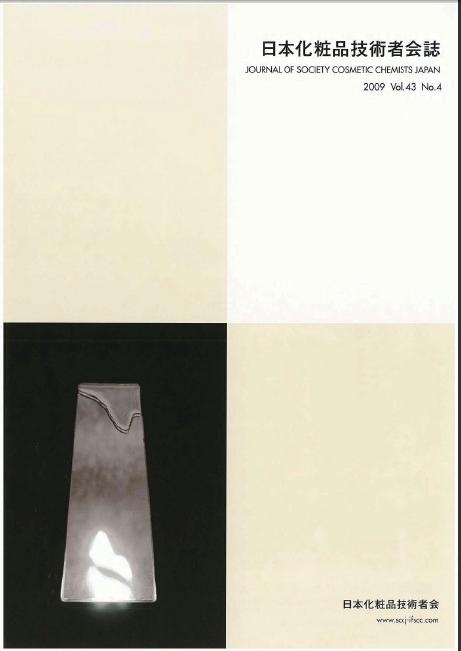
- Issue 4 Pages 251-
- Issue 3 Pages 179-
- Issue 2 Pages 85-
- Issue 1 Pages 2-
- |<
- <
- 1
- >
- >|
-
Ayano Nakamura2018Volume 52Issue 4 Pages 251-259
Published: December 20, 2018
Released on J-STAGE: December 20, 2018
JOURNAL FREE ACCESSAqueous thickeners play an important role in both functional and sensory aspects of cosmetic formulas. We report our attempts to use microgels as intelligent aqueous thickeners and quantify the texture of the cosmetic, by using the rheological properties. Agar microgel dispersion prepared from agar bulk-gel was then granulated by a high-speed mixer (5000 rpm). Another microgel was created with an inverse microemulsion polymerization system. The thickening effect of the microgel prepared by using this system was higher than that of the agar microgel. The flow characteristic parameters of the microgels were analyzed by using the Herschel-Bulkley equation. The power index n in the H-B eq. revealed that both the microgels were expected to give a refreshing-feeling. Flow properties of cosmetic lotions, containing various kinds of aqueous thickeners, were studied by creep measurement, and parameters were calculated from their rheological data based on the empirical Nutting equation. There was some correlation between the time dependency parameter α and some sensory evaluation points, as assessed by human panels. Simple linear regression analysis revealed that the evaluation scores of slimy-feeling, sticky-feeling, refreshing-feeling, and penetrating-feeling cosmetic lotions could be reduced to numerical data by the parameter α. This quantification method for the texture of cosmetic products will be a useful tool for efficient development of cosmetic formulas.
View full abstractDownload PDF (1093K)
-
Kei Watanabe, Miharu Nishida, Kanako Nishimura, Yoriko Mune, Yuji Mats ...2018Volume 52Issue 4 Pages 260-268
Published: December 20, 2018
Released on J-STAGE: December 20, 2018
JOURNAL FREE ACCESSThe formation of micellar solutions with hydrophilic surfactants is generally used to include oily substances into transparent water-based formulae. However, a restriction exists on hydrophilic surfactants due to their sticky feeling arising from long hydrophilic groups. We found a stable transparent dispersion of a lipophilic polyether-modified silicone (PEMS) in combination with an ionic surfactant by a certain procedure. Various analyses revealed that it is a 10-100 nm sized vesicle/micelle complex consisting of bi-molecular membranes. Although there are several reports on the vesicle formation of PEMS, the practical stability has been insufficient because of the high fluidity of the membrane. The present vesicle/micelle complex can solubilize silicone oils, which have been considered difficult, resulting in a feature of good spreadability onto surfaces. In addition to that, it shows a non-sticky, highly permeable feeling owing to the formation of a lamellar liquid crystalline phase by a water evaporation on application despite the high glycerol concentration. The present moisturizing lotion fulfilled mutually exclusive events of high skin hydration to prepare for future skincare items: a moisturizing lotion with an important function and a highly comfortable texture.
View full abstractDownload PDF (1345K) -
Nobuyuki Yoshida, Masamitsu Urakawa, Atsushi Oodaira, Masao Goto2018Volume 52Issue 4 Pages 269-274
Published: December 20, 2018
Released on J-STAGE: December 20, 2018
JOURNAL FREE ACCESSOatmeal is the food product resulting from the grinding or rolling of oat grain (Avena sativa L.) (which is thus crushed into thin flakes) after dehulling. Further, the finely milled product is referred to as colloidal oatmeal (COM). Oat grain has natural phytochemicals such as phenolic compounds, tocols, and polysaccharides. They lead to anti-irritancy, redness reduction and moisturization effects for humans. For that reason, COM was traditionally used as a bath treatment or skincare ingredient in Europe and the United States. In this research, we compared extruded colloidal oatmeal (ExtCOM) which added a hydrothermal process before fine milling and ordinary COM in terms of particle size distribution, β-glucan content and DPPH radical quenching activity. As a result, ExtCOM has a smaller particle size and enhanced content of both β-glucan and antioxidant elucidated in water. We concluded that the difference is due to the extrusion process, which affects mainly the physiological structure of oat grain. This result is expected to strongly improve the bioavailability of COM as a healthcare ingredient.
View full abstractDownload PDF (930K) -
Misaki Doi, Sayaka Nakamura, Norihisa Taira, Yushi Katsuyama, Hitoshi ...2018Volume 52Issue 4 Pages 275-281
Published: December 20, 2018
Released on J-STAGE: December 20, 2018
JOURNAL FREE ACCESSAscorbic acid (AsA) is well-known as a multifunctional water soluble vitamin that shows antipigmentation effects in epidermal melanocytes and stimulates collagen synthesis in dermal fibroblasts. However, AsA has some disadvantages in cosmetic formulations since it is quite unstable in aqueous solutions and emulsions. To improve the stability of AsA in cosmetic formulations, we developed a novel AsA derivative, bis-glyceryl ascorbate (VC-DG), which introduces 2 glycerol groups into AsA, and confirmed that VC-DG has a higher stability than AsA and maintains its bioactivities as well as AsA. In this study, we evaluated the skin moisturizing effects of VC-DG focusing on the cornified cell envelope (CE) to develop its unique biological activities. As the results, VC-DG up-regulated the mRNA and protein expression levels of CE-related substances, such as involucrin, loricrin and transglutaminase-1, which in turn significantly increased CE formation in normal human epidermal keratinocytes. Additionally, topical application of VC-DG increased the protein expression levels of involucrin, loricrin and transglutaminase-1 in the spinous and/or granular cell layers of reconstructed human epidermal equivalents. In a human volunteer test, the application of VC-DG increased the skin surface water content. Therefore, we consider VC-DG to be an effective ingredient that improves skin hydration through enhancing CE formation.
View full abstractDownload PDF (1122K)
- |<
- <
- 1
- >
- >|